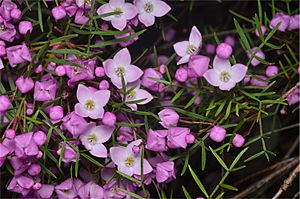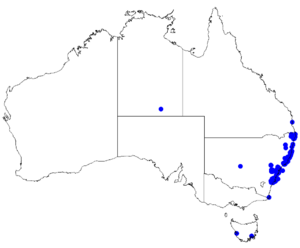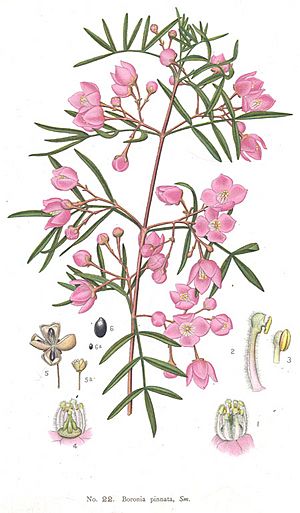Boronia pinnata facts for kids
Quick facts for kids Boronia pinnata |
|
|---|---|
 |
|
| Pinnate boronia in the ANBG | |
| Scientific classification | |
 |
|
| Occurrence data from Australasian Virtual Herbarium |
Boronia pinnata is a beautiful plant that belongs to the citrus family, called Rutaceae. You can only find it growing naturally in New South Wales, Australia. This plant is a straight, woody shrub with special leaves that look like feathers. It also has pretty pink flowers that grow in groups of three to forty. You'll often see it flowering in spring and early summer, especially along the coast between Ballina and Jervis Bay.
Contents
What Does Boronia pinnata Look Like?
Boronia pinnata is a woody shrub that usually grows up to about 1.5 meters (5 feet) tall. It's mostly smooth and hairless, except for its flowers.
Leaves and Stems
The leaves of this plant are quite special because they are "pinnate." This means they have smaller leaflets arranged along a central stem, like a feather. Each leaf can be between 18 and 60 millimeters long and 14 to 54 millimeters wide. The small leaflets are usually 5 to 29 millimeters long and 1 to 3 millimeters wide. The part that connects the leaf to the stem is called a petiole, and it's about 6 to 17 millimeters long.
Flowers and Fruit
The flowers of Boronia pinnata are bright pink and grow in groups of three to twenty, sometimes even forty! These groups appear where the leaves meet the stem, which is called the leaf axil. Each group of flowers grows on a stalk called a peduncle, which is 5 to 20 millimeters long. Individual flowers are on smaller stalks called pedicels, about 6 to 30 millimeters long.
Each flower has four small, triangular parts called sepals, which are about 1 to 1.5 millimeters long. It also has four bright pink petals, which are 5 to 11.5 millimeters long and might have a few hairs on the back. Inside the flower, there are eight stamens, which are the parts that produce pollen, and they have hairy edges.
This plant flowers from September to January. After flowering, it produces a smooth, dry fruit called a capsule, which is about 4 to 5 millimeters long.
How Boronia pinnata Got Its Name
The plant Boronia pinnata was first officially described in 1798 by a scientist named James Edward Smith. He wrote about it in his book Tracts relating to natural history.
The second part of its scientific name, pinnata, comes from a Latin word meaning "feathered" or "plumed." This name was chosen because its leaves look like feathers. At the time, this was the only type of boronia with feather-like leaves that Smith had described.
Where Does Boronia pinnata Grow?
You can find Boronia pinnata growing in dry forests and heathlands. It prefers areas with sandstone soil near the coast. Its natural home stretches from the Nowra area all the way up to Ballina in New South Wales.
Growing Boronia pinnata in Your Garden
If you like gardening, Boronia pinnata is one of the easier boronia plants to grow. It does best in a spot that is somewhat protected from strong winds. It also likes to have rocks nearby, which can help its shallow roots grow well. Giving it a light trim now and then can help it stay healthy and look its best.
See also
In Spanish: Boronia pinnata para niños


